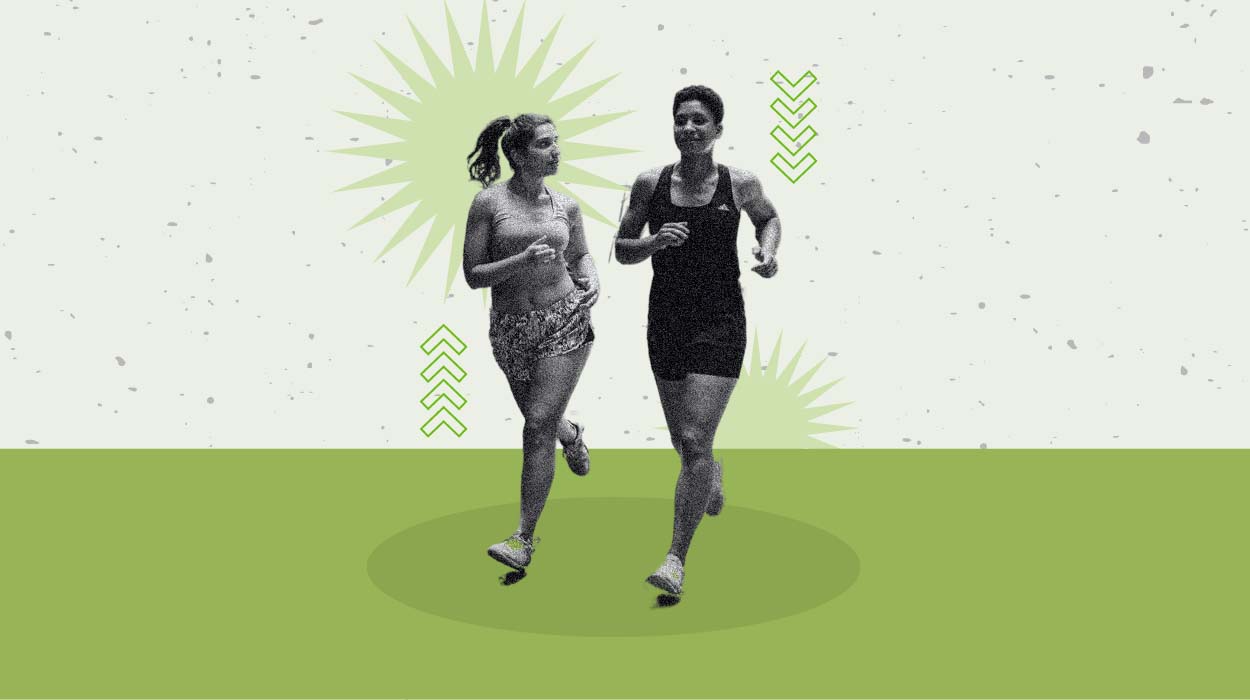
A common misconception that some people hold is that running is the easiest physical activity as it does not require strong muscles. While this idea has made it appealing to some people, it’s not true at all. Sure, you may not be lifting anything off the ground, but the core workout for runners and a strong core can make the difference between a so-so runner and an excellent runner.
Other than being an alternative for fat burners that help with weight loss, running either freely or in organized sports such as track and field is a test of your whole body, not just your legs. So it’s best to make sure you pass that test with flying colors by working on your core.
Below are some exercises for a quality core workout for runners that can help improve your performance, whether you run on your own or as part of an athletic event.
Best Core Workout For Runners
These 10 exercises help strengthen the abdominals of the core routine for runners:
Core Workout For Runners To Try Now
Plank
This classic isometric workout is the poster child of effective core exercises for runners. While it may be a challenge for untrained people due to the massive amount of endurance needed to hold the position, it’s just as simple as it is effective. Not only has it been proven to improve overall fitness[1] and strengthen core muscles, but planks have also been shown to increase strength, endurance, flexibility, and heart activity, all of which are important components for runners.
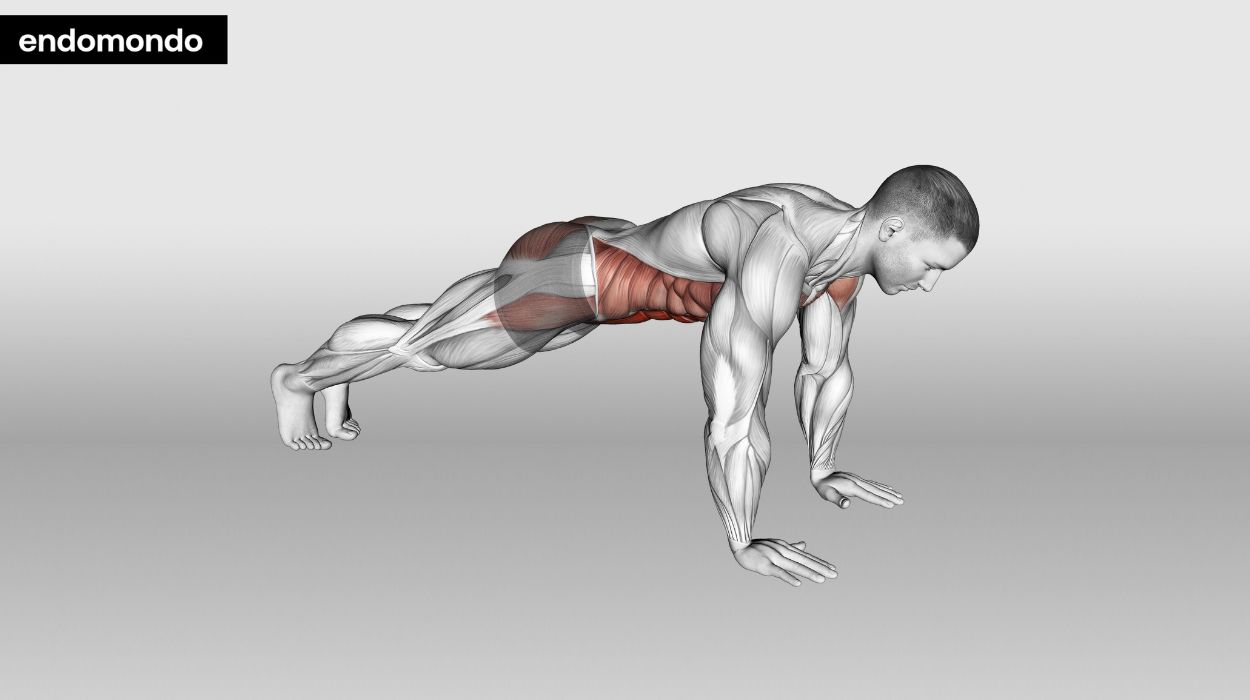
How to do:
- Start by lying on your stomach with your body extended.
- Lift yourself on your toes and elbows. Keep your toes hip distance apart and your elbows directly under your shoulders. Your back should form a straight line. Brace your abs.
- Maintain this plank position for as long as possible – 45-60 seconds is recommended, but you can hold it even longer as you get used to it.
Tips:
- Position your elbows directly under your shoulders to ensure optimal support and alignment.
- Tighten your abdominal muscles throughout the exercise to support your back and enhance stability.
- Maintain a straight line from your head to your heels, avoiding sagging or lifting hips.
Optimal Sets and Reps: Perform 3-4 sets, holding each plank for 20-30 seconds.
Crunch
Here we have another classic and effective core exercise. However, crunch is not as impressive as it only focuses on abdominal muscles; it does not engage your obliques or other core muscles. Even so, this exercise still contributes to the essential stable core that every runner needs.
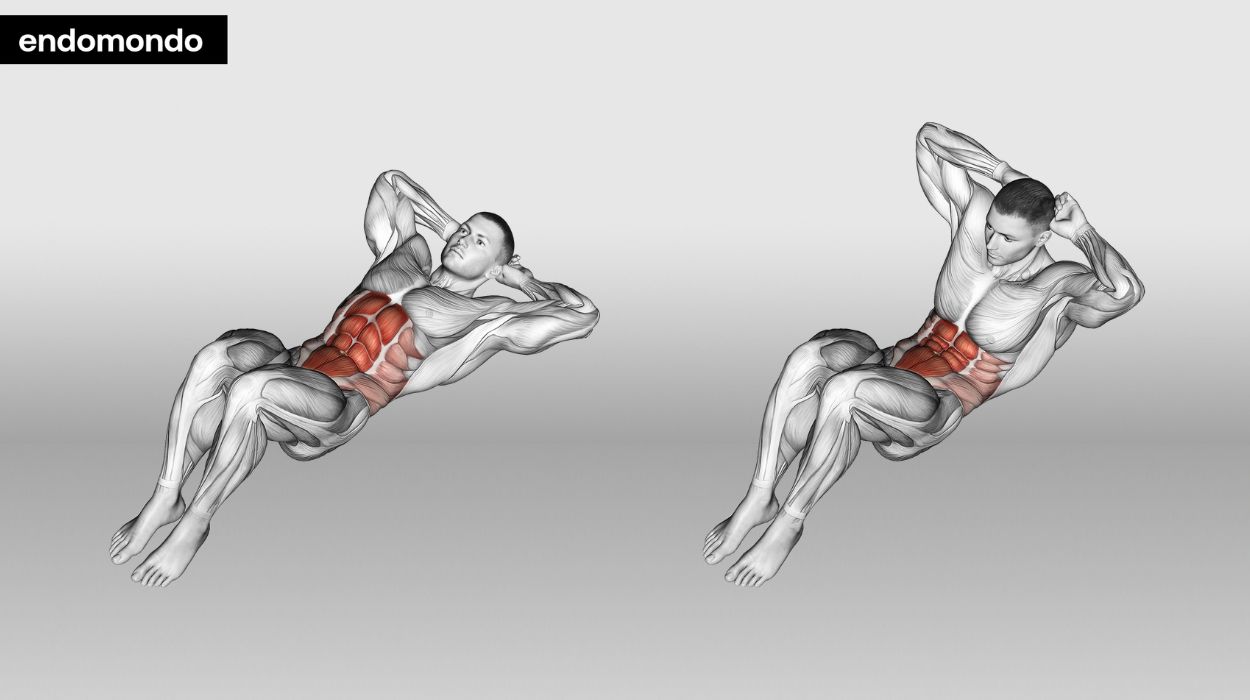
How to do:
- Start by lying on your back with your feet flat on the floor at hip-width.
- Bend your knees, cross your arms across your chest, and with your core muscles engaged. Bring your shoulders and upper back off the ground as you lift your chin to the ceiling.
- Slowly return to the starting position.
- Continue for 2-3 sets of 10 to 15 reps.
Tips:
- Focus on using your abdominal muscles to lift your shoulders off the ground, keeping your neck relaxed.
- Lift and lower your torso slowly to increase muscle engagement and avoid momentum.
- Plant your feet firmly on the ground to stabilize your lower body and allow better focus on the abs.
Optimal Sets and Reps: Aim for 3 sets of 10-15 repetitions each.
Russian Twists
The Russian Twists aren’t only good for strengthening your core and obliques. It also doubles as a workout for your hip flexors. Increasing lower body strength can be valuable for runners looking to improve their sprint[2] by boosting their leg muscle endurance, allowing them to run farther.
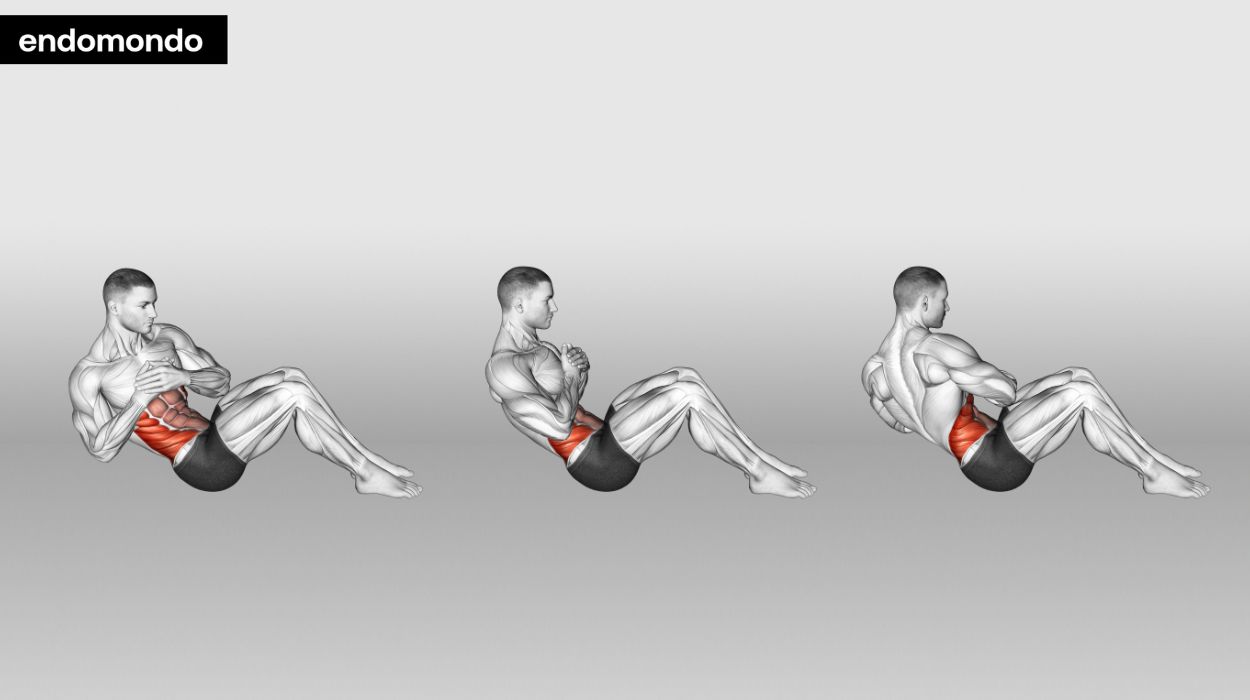
How to do:
- Start by sitting with your knees bent and heels hovering an inch above the floor.
- Brace your abs and lean back slightly. Your legs and torso should form a wide V shape.
- Clasp your hands together and slowly twist your torso from side to side, bringing your hands to the floor on either side of your hips. Hitting both sides counts as one rep.
- Continue for two to three sets of 10 to 12 reps.
Tips:
- Keep your abs engaged throughout the exercise to support your spine and increase effectiveness.
- Twist your torso fully to each side to engage the obliques and maximize the range of motion.
- For added intensity, lift your feet slightly off the ground, but ensure it doesn’t compromise your form.
Optimal Sets and Reps: Perform 3 sets of 10-15 repetitions on each side.
Windshield Wipers
The Windshield Wipers aren’t just a powerful core exercise to tone your obliques and lower back. For runners that go along tracks or running paths that twist and turn, windshield wipers can also help build rotational core strength to help you make effective turns along a track or path. However, it is important to note that this exercise still requires serious stability to do it properly.
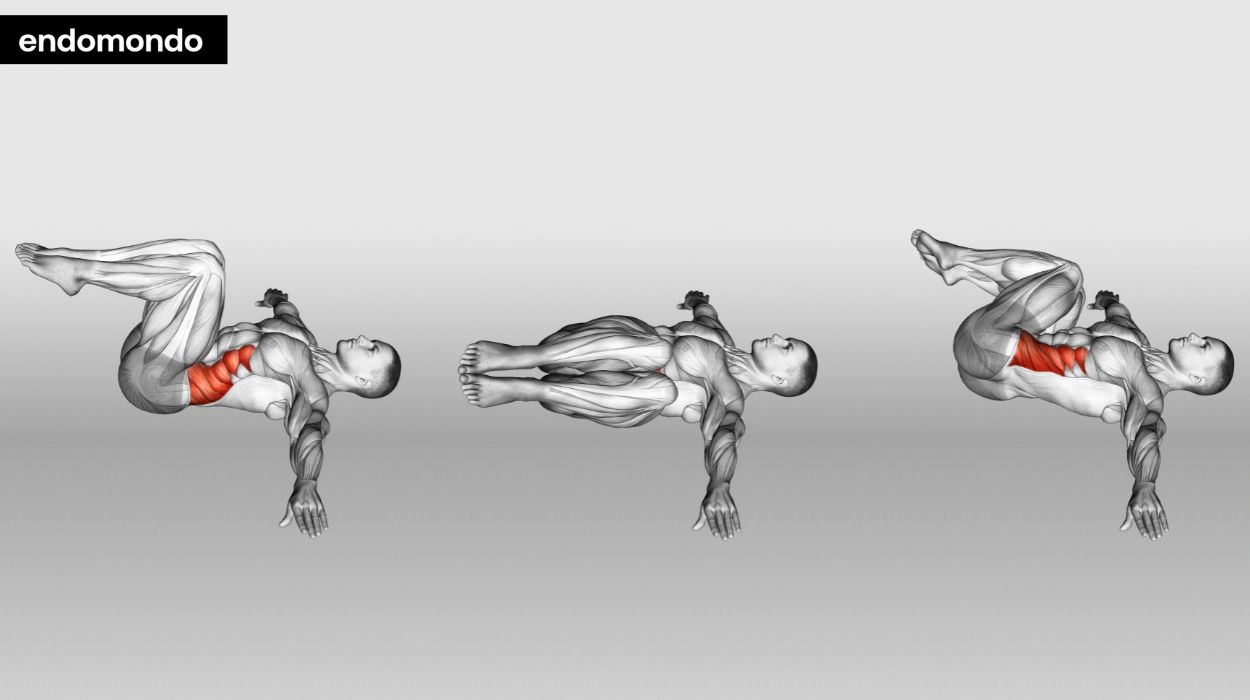
How to do:
- Start by lying on your back, keeping your arms straight out to your sides in line with your shoulders. Lift your legs, bending your knees at 90 degrees.
- Rotate your hips to one side to move your legs, but do not let your legs touch the floor.
- Lift your legs back to the center, then rotate your hips to the other side. This counts as one rep.
Tips:
- This stabilizes your upper body and ensures the core does the work.
- Move your legs from side to side in a controlled manner, avoiding any rapid or jerky motions.
- Tighten your abdominal muscles to control the movement and protect your lower back.
Optimal Sets and Reps: Perform 2-3 sets of 8-12 repetitions to each side.
Superman
This superhero’s well-toned physique is ideal for runners, and this exercise named after him can at least emulate his build and movement. This exercise targets the lower back, glutes, and hamstrings, among other muscle groups, including the abs.

How to do:
- Start by lying face down, fully extending your arms and legs straight. Keep your head relaxed by looking at the floor in front of you.
- Brace your abs and raise your arms and legs a few inches off the ground, keeping your body fully extended. Hold this position for three to five seconds.
- Slowly lower your arms and legs back to the starting position. This counts as one rep.
Tips:
- As you lift, focus on using your lower back and glutes to raise your arms and legs.
- Align your neck with your spine; avoid looking up or tucking your chin too much.
- Lift and lower your limbs slowly and smoothly to maximize muscle engagement and reduce the risk of injury.
Optimal Sets and Reps: Perform 3 sets of 8-12 repetitions.
Dead Bug
This exercise may not sound like the most appealing from its name, but it’s effective in building every muscle of your core. It also involves your arms and legs, which can further improve your performance as a runner.
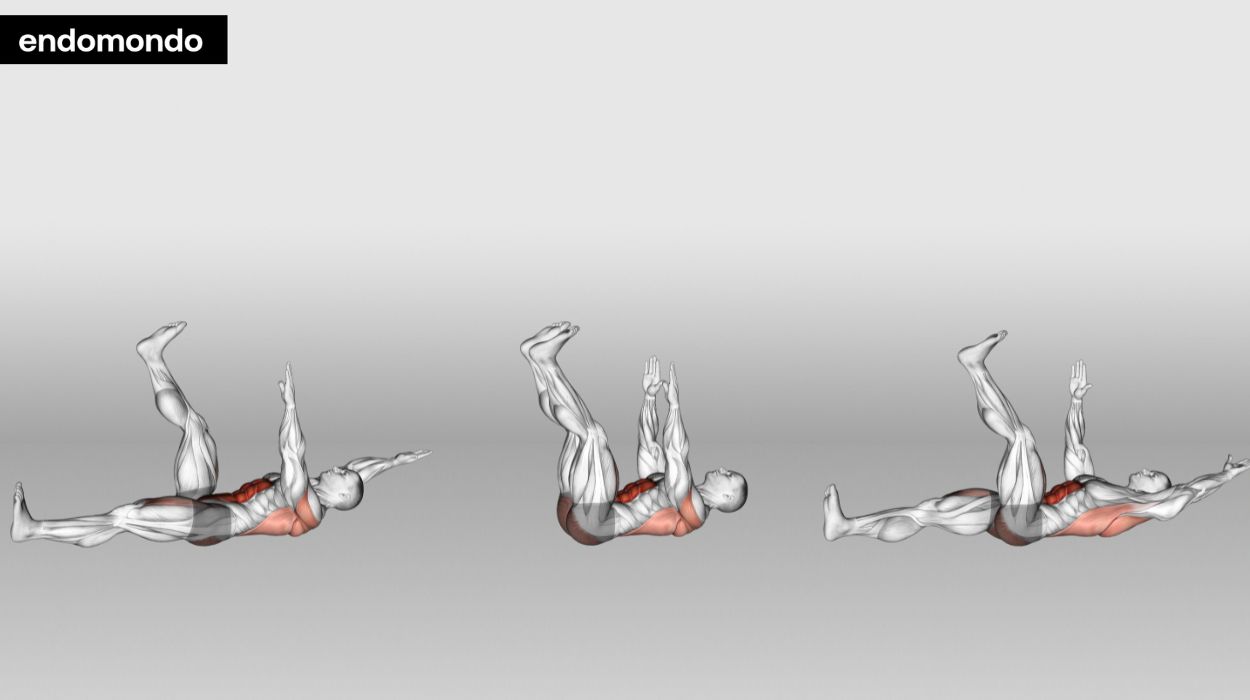
How to do:
- Start by lying on your back, bending both your hips and knees at 90 degrees. Raise both arms, with your fingertips pointing towards the ceiling.
- Extend your right leg forward, and move your opposing arm past your head.
- Return both to the starting position before moving your left leg and right arm while keeping a stable core. This counts as one rep.
Tips:
- This ensures your core is engaged and protects your spine.
- Lower one arm behind your head and the opposite leg towards the floor in a controlled manner.
- Inhale as you extend, and exhale as you return to the starting position to maintain rhythm and core engagement.
Optimal Sets and Reps: Aim for 3 sets of 8-10 repetitions per side.
Mountain Climbers
Like the Dead Bug, Mountain Climbers are another effective core workout that targets your core and your arms, shoulders, and hamstrings. For runners, Mountain Climbers is also an ideal exercise to include in your workout if you want to improve your reflex speed, endurance, and joint movement.
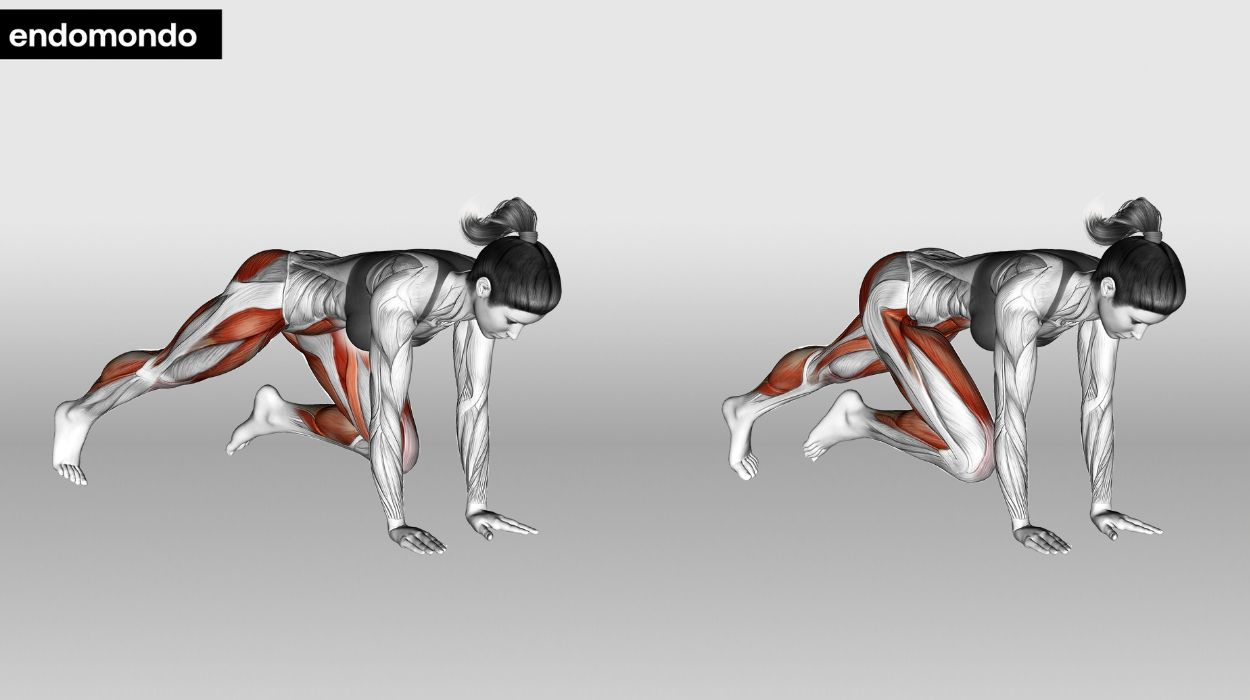
How to do:
- Start in a full plank position, with your weight evenly distributed between your hands and toes.
- Pull your left knee into your chest as far as you can.
- Switch legs – Pull your right knee into your chest as you bring your left knee back. This counts as a rep. Be sure to move swiftly.
Tips:
- Start in a strong plank, keeping your back flat and core engaged to support your spine.
- Alternate bringing each knee to your chest in a controlled, but brisk, manner.
- Avoid lifting your hips too high; keep them in line with your shoulders for effective engagement.
Optimal Sets and Reps: Perform 3-4 sets of 15-20 repetitions per leg.
Jump Squat
Although a runner’s vertical jump isn’t a vital component to improve on, the fact that this beginner-level exercise targets your legs and thighs can improve your performance as you run. Of course, Jump Squats also target your abdominal muscles, so there’s no reason not to include this in your workout.
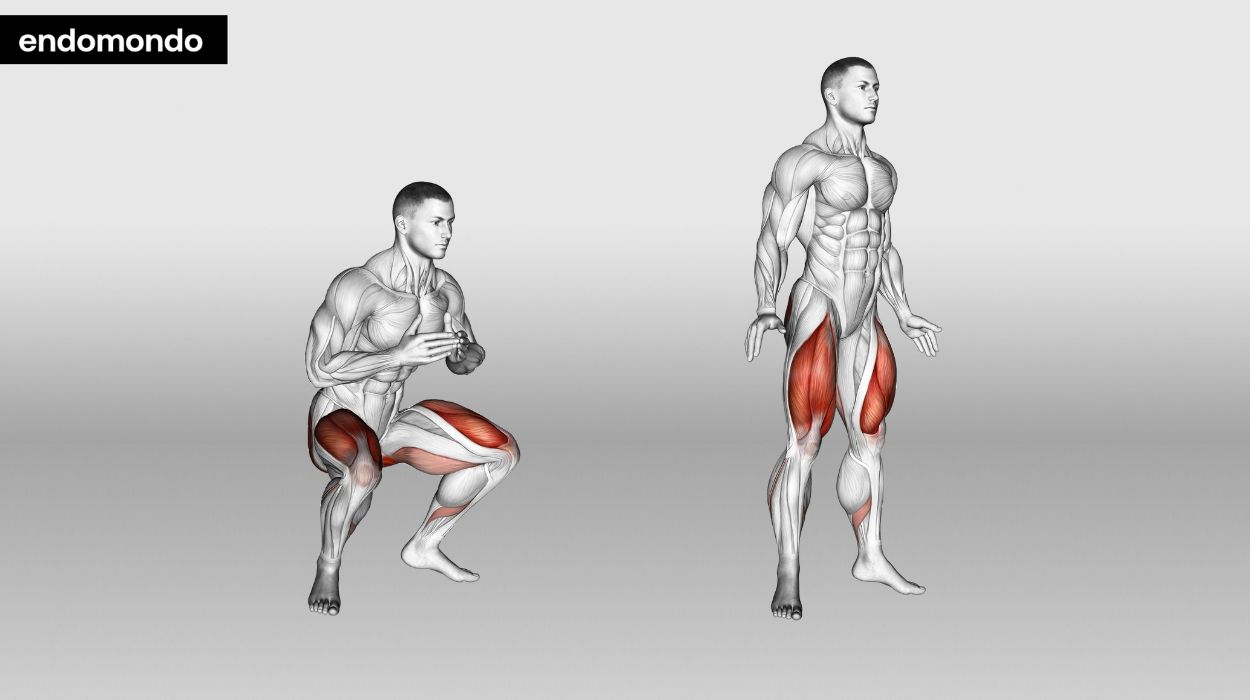
How to do:
- Start by standing with your feet at shoulder width. Bend your knees and push your hips back into a squatting position.
- Swing your arms up, straighten your legs, and jump off the floor, moving from your hips. Then land on the balls of your feet back into the starting position.
Tips:
- Land softly on your feet to absorb the impact and protect your joints.
- Use your hips and knees to generate the power needed for the jump, driving upwards forcefully.
- Keep your knees aligned with your toes and avoid letting them cave inwards during the squat and jump.
Optimal Sets and Reps: Aim for 3 sets of 8-12 repetitions.
Flutter Kicks
These Flutter Kicks are all about toning your core muscles and hip flexors.
Flutter Kicks are a lying-down abdominal exercise where one alternates lifting their straight legs up and down in a small, rapid motion. This exercise targets the lower abs, hip flexors, and core stability, and is excellent for improving endurance and toning the abdominal region.
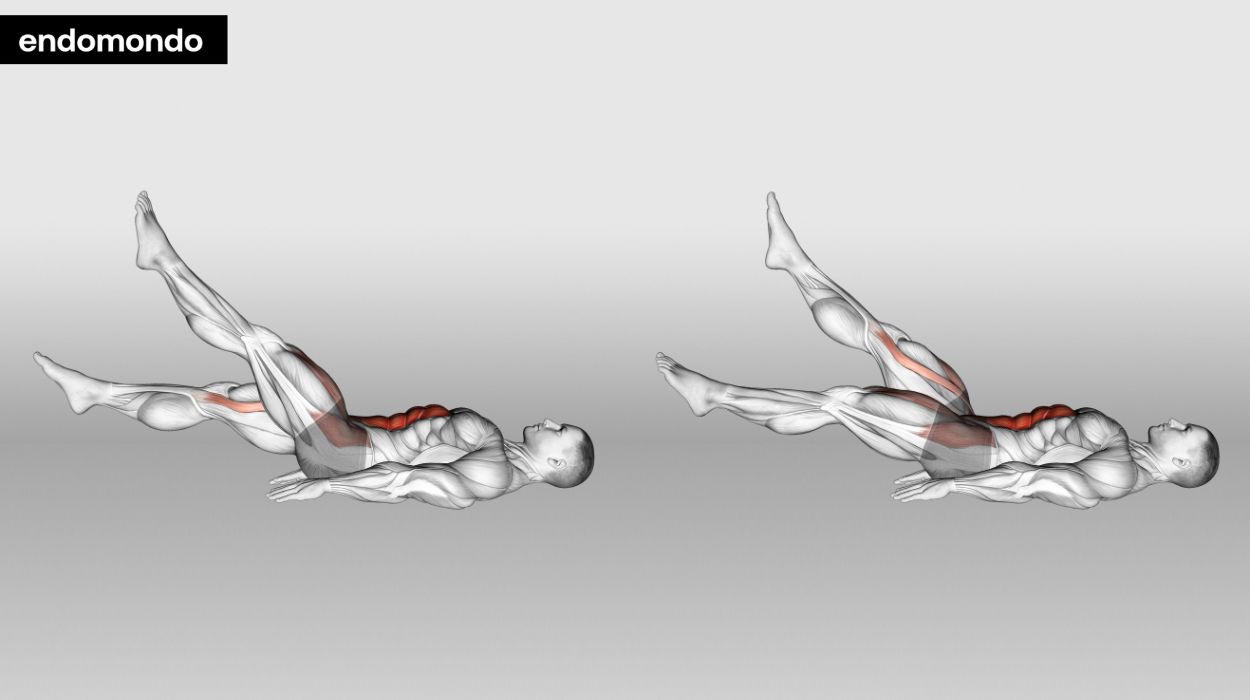
How to do:
- Start by lying on your back with your arms at your sides.
- Extend your legs at a 45-degree angle. Raise your head, neck, and shoulders off the ground.
- Brace your abs and kick your legs up and down, alternating between your legs. Keep your lower back on the ground at all times.
- Continue for 3 sets of 30 to 60 seconds each.
Tips:
- This helps engage your core and prevents strain on your lower back.
- Extend your legs fully and move them in a controlled, steady motion to maximize engagement.
- Maintain a consistent breathing pattern to help stabilize your core and enhance endurance.
Optimal Sets and Reps: Perform 3 sets of 20-30 seconds each.
Bird Dog
This final exercise primarily targets your abdominal muscles, but runners may find some benefit in the fact that their legs – namely your glutes and hip flexors – can also be toned through this exercise.
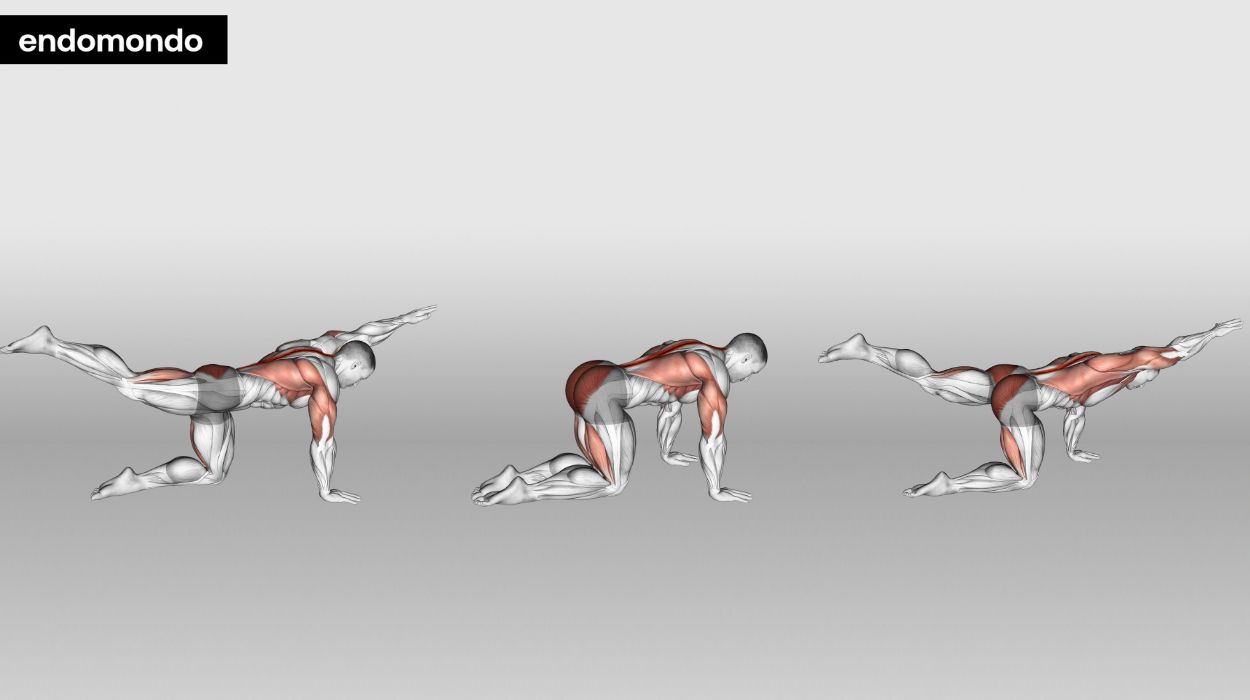
How to do:
- Start on your hands and knees, with both underneath your shoulders and hips, respectively.
- Extend your left leg behind you and your right arm in front of you at the same time, keeping them straight. Hold this position for three to five seconds, then return to the starting position. Switch sides and repeat.
- Continue altering sides for 3 sets of 10 reps for each side.
Tips:
- Keep your back flat and head in line with your spine to prevent strain.
- Slowly extend the opposite arm and leg, keeping movements smooth and controlled for better balance and muscle engagement.
- Focus on tightening your abdominal muscles to improve stability and effectiveness.
Optimal Sets and Reps: Aim for 3 sets of 8-10 repetitions on each side.
Why Runners Should Have Strong Core?

A strong and stable core[3] can prove useful for runners. Your core is responsible for keeping you upright and steady, decreasing any wobbling that may occur as you move your arms and legs.
Certain core exercises help to build abdominal muscles[4] by thickening them, making them more stable. Even if you’re not a runner, working out to strengthen your core can enhance your performance in various other sports and physical activities.
Safety Tips
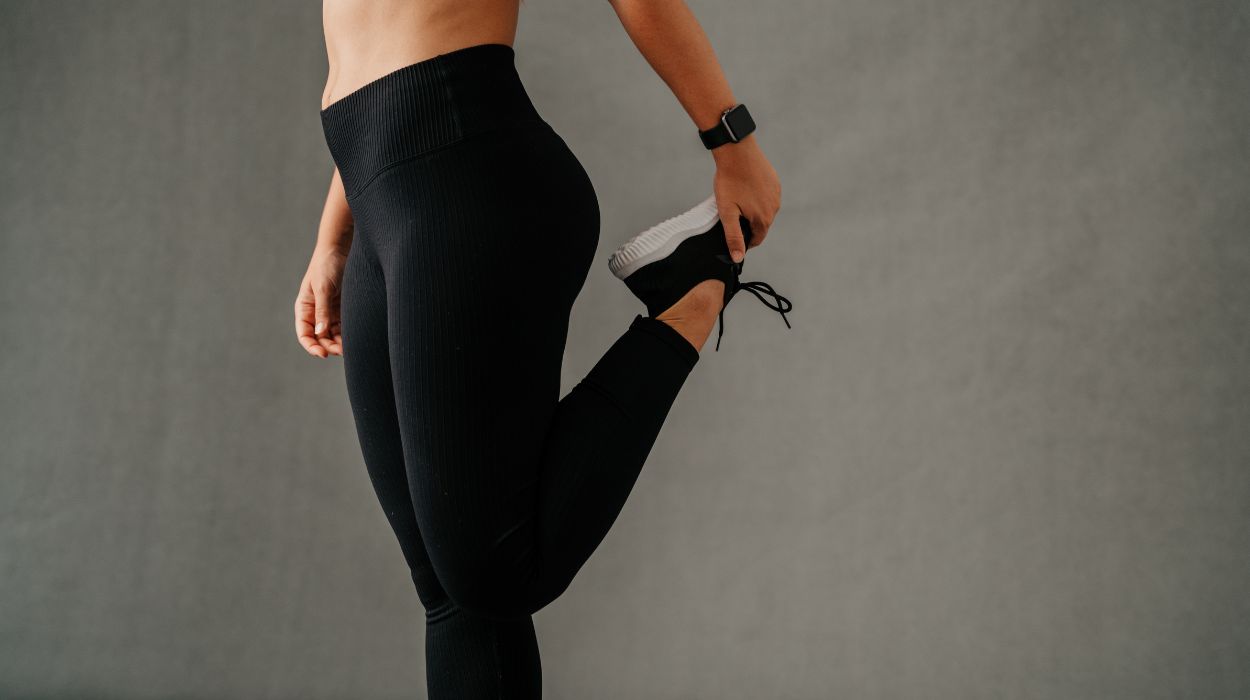
With just about any kind of exercise, it is important to stay safe while performing any ab workout for runners. Try utilizing the following tips:
- Do light warmups before you begin any of these workouts.
- Give your body a few days a week to rest. Overworking your body through exercise does more harm than good.[5]
- Maintain proper form, and remember to breathe!
- Do cool-down exercises after doing any of these workouts.
- Be sure to consume a sufficient amount of calories and nutrients beforehand. Taking supplements, if necessary, can help. If you are looking to lose weight, adding a weight-loss supplement may speed things up.
The Takeaways
It may not seem like it, but running does require some specific muscle-building. Having a strong core can improve your running performance by providing proper balance and stability that won’t slow you down. With so many ab exercises for runners to choose from, it’s certainly possible to work on their abdominal muscles and improve their performance.
Frequently Asked Questions
Yes, it allows for smooth and steady movement as you run.
Three to four days of working out should suffice.
30 to 60 minutes should be enough for a runner’s core workout.
No, working out too frequently prevents your body from being able to recuperate.
Resources
- Park, S.-K., Lee, K.-S., Heo, S.-J. and Jee, Y.-S. (2021). Effects of High Intensity Plank Exercise on Physical Fitness and Immunocyte Function in a Middle-Aged Man: A Case Report. Medicina-lithuania, [online] 57(8), pp.845–845. doi:https://doi.org/10.3390/medicina57080845.
- Seitz, L.B., Reyes, Á., Tran, T.T., Sáez, E. and G. Gregory Haff (2014). Increases in Lower-Body Strength Transfer Positively to Sprint Performance: A Systematic Review with Meta-Analysis. Sports Medicine, [online] 44(12), pp.1693–1702. doi:https://doi.org/10.1007/s40279-014-0227-1.
- Hsu, S.-L., Oda, H., Saya Shirahata, Watanabe, M. and Sasaki, M. (2018). Effects of core strength training on core stability. Journal of Physical Therapy Science, [online] 30(8), pp.1014–1018. doi:https://doi.org/10.1589/jpts.30.1014.
- da, I., Alonso-Calvete, A., M. Soto-González and María, E. (2021). How Do the Abdominal Muscles Change during Hypopressive Exercise? Medicina-lithuania, [online] 57(7), pp.702–702. doi:https://doi.org/10.3390/medicina57070702.
- Kreher, J.B. (2016). Diagnosis and prevention of overtraining syndrome: an opinion on education strategies. Open access journal of sports medicine, [online] Volume 7, pp.115–122. doi:https://doi.org/10.2147/oajsm.s91657.




